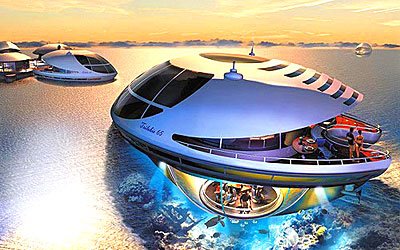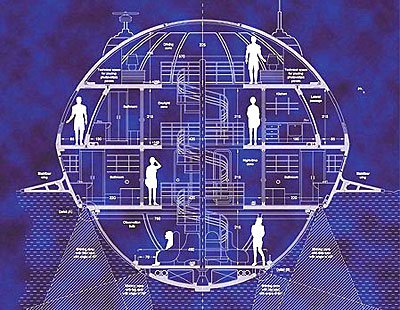Extreme Undersea Habitats!
:: How about an island of unique, self sufficient, non-polluting, semi-submerged dwelling environments?
++ Sea Tech: Giancarlo Zema / Italian Naval Architect / Sub-Find
Life, say the experts, began in the sea. And if the way we spend our vacations is an accurate indicator, there are few things we enjoy more than revisiting our submerged roots. Cavorting with dolphins, badgering sharks from the safety of steel cages and photographing exotic fish through the portholes of tourist submarines fascinates landlubbers from Prague to Peoria.
 For those who find these forays into Neptune's realm too brief, Italian naval architect Giancarlo Zema has the perfect dream home, the Trilobis 65. Part yacht and part submarine, it could possibly convince Captain Nemo to hang a "for sale" sign on the Nautilus.
For those who find these forays into Neptune's realm too brief, Italian naval architect Giancarlo Zema has the perfect dream home, the Trilobis 65. Part yacht and part submarine, it could possibly convince Captain Nemo to hang a "for sale" sign on the Nautilus.At first glance, the Trilobis 65 (named after the Trilobites, prehistoric creatures that lived in the sea 500 milion years ago) looks as if it would be more at home soaring into the sky than plying the waters of atolls, bays and maritime parks. Looking at a computer image of the bow conjures up visions of the flying saucers in science fiction films.
 The Trilobis's blueprints, however, reveal a nautical heritage that reaches back to the humble dugout while simultaneously embracing 21st century technologies that include high-strength composites, photovoltaic panels, foam-reinforced fiberglass, and nonpolluting hydrogen fuel cells.
The Trilobis's blueprints, however, reveal a nautical heritage that reaches back to the humble dugout while simultaneously embracing 21st century technologies that include high-strength composites, photovoltaic panels, foam-reinforced fiberglass, and nonpolluting hydrogen fuel cells. Perhaps the most striking feature of Zema's design is one that reflects his willing recognition of the great unspoken truth about luxury yachts. Powerful engines and sleek hulls aside, these vessels typically stick close to home. Acknowledging the fact that well-heeled mariners often prefer to keep their floating palaces moored inches from the dock, Zema also designed a special type of marina that will enable like-minded Trilobis owners to create their own floating villages. The traditional rectangular dock will disappear, to be replaced by a roughly 60 foot in diameter circular island in the shape of a 6-tooth gear, into which individual yachts fit like pieces of a jigsaw puzzle.
Perhaps the most striking feature of Zema's design is one that reflects his willing recognition of the great unspoken truth about luxury yachts. Powerful engines and sleek hulls aside, these vessels typically stick close to home. Acknowledging the fact that well-heeled mariners often prefer to keep their floating palaces moored inches from the dock, Zema also designed a special type of marina that will enable like-minded Trilobis owners to create their own floating villages. The traditional rectangular dock will disappear, to be replaced by a roughly 60 foot in diameter circular island in the shape of a 6-tooth gear, into which individual yachts fit like pieces of a jigsaw puzzle.Note from technophile: Descending from the top to the craft's third level, yachtsmen will enter what Zema calls the day area. Its use of space is a reminder that spherical structures are more efficient than rectangular ones. As with the space above it, the day area is surrounded by self-shading glass, offering a panoramic view from the gourmet kitchen, formal dining area and three seating groups. On this level, the spiral stairway serves a secondary function of separating interior and exterior spaces. Sliding glass doors fully retract, opening onto a teak deck.Returning inside and following the stairway down one more flight leads to what is known as the night zone. The Trilobis sleeps six, with a premium on privacy. The design calls for two single and two double bedrooms, each with a private bathroom. With the deck at this level beginning 3 ft. below the waterline, the wraparound window cuts off at eye level.This level also houses the yacht's propulsion system, which consists of two electric motors. Each is rated at about 300 hp. They are powered by hydrogen-fed Ballard fuel cells. The hydrogen for the fuel cells will be stored in a pair of 240-gal. tanks located just aft of the single bedrooms. The fuel supply is not intended for ocean crossings, but to be sufficient for moving the yacht to nearby reefs to explore seasonal changes in marine life and catch a true fish-eyes view of unusual migrating species.:: Source: [Sub-Find]
:: Innovation: Technology that allows anyone to live in a unique environment inside of a self-sufficient, nonpolluting dwelling that exists in unison with the surrounding ocean !
:: Available: Unknown.
:: Cost: $4 - 5 million.




















0 Comments:
Post a Comment
<< Home